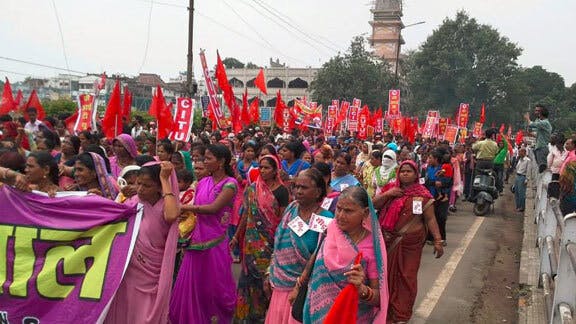Indian workers stage 150 million-strong strike

An estimated 150 million workers struck in India on 2 September in what was possibly the largest general strike in history.
The strike, called by 10 union federations, affected the banking, transport and manufacturing industries; schools, mines and entire cities also were shut down. The action was strongest in the states of Kerala and West Bengal, which have a history of left wing and communist activity.
This is the fourth all-India strike called in the last six years. The Central Trade Unions, along with the Central Government Employees Federations, have repeatedly clashed with governing parties, first the Congress-led United Progressive Alliance and now the Bharatiya Janata Party-led National Democratic Alliance.
Since the mid-1990s, governments have been trying to outdo each other to be the most business friendly: smashing wages, privatising state industries, stripping land from peasants and waging brutal counter-insurgency campaigns in Kashmir and the “Red Corridor” in the country’s east, where Maoist guerrilla groups operate.
The BJP, led by Narendra Modi, was swept into power in a landslide victory in national elections last year. Modi promised to push through a range of policies to boost profits and expand India’s economy. The Economist wrote prior to the elections:
“Indian industry is in a funk and has decided that one man is the answer … It is only a slight exaggeration to say that almost everyone in a suit and with a pulse in the private sector wants Narendra Modi, the chief minister of Gujarat state, to become prime minister after elections due by May 2014 … [Modi] will be India’s Margaret Thatcher, a populist reformer who forces through measures that put the economy on a higher growth path.”
Yet Modi, faced with political opposition, has been forced to backtrack on a number of policies. The unions are now calling on the government to implement a 12 point charter to guarantee a basic standard of living for India's poor and workers.
The charter calls for a guaranteed minimum wage, social security for all workers and a universal pension system, among other things. Arguably the most important points in the charter relate to enforcement of basic labour laws and a pledge not to amend the current standards.
It has become an article of faith among the capitalist class that India's labour laws are archaic, unwieldy and a great impediment to progress. The World Bank has routinely called for the trashing of workers’ rights. In 2008, for example, it said: “India's labour regulations – among the most restrictive and complex in the world – have constrained the growth of the formal manufacturing sector where these laws have their widest application”.
In reality, however, labour laws are routinely flouted and ignored. The capitalist class takes any opportunity to further drive down conditions and wages and increase profits.
This strike was a step forward for the left in India. Decades of in-fighting and wavering have weakened the labour movement, as the economy has increased in size. The International Labour Organization wrote in 2010: “The proportion of unionisation rates is as low as 6.3 per cent of the total workforce and is still fragmented by political ideologies. Union inter- and intra- rivalry is high.” The following year, the New York Times noted:
“India’s trade union movement has been in decline since efforts to liberalise the economy began in 1992. Historically unionised sectors like the textile industry had already undergone turbulent reorganizations in the 1980s; the trend accelerated post-liberalisation as the state became less inclined to intervene in labour disputes. Since then, permanent employees have often been laid off in favour of contract workers. Union leaders have been fired, bought out, intimidated or, sometimes, assassinated.”
Nationally, the various left-reformist and communist groups have also declined in membership and influence. However, the ruling classes still see the left as a threat. In Kolkata, the capital of West Bengal, members of the Communist Party of India (Marxist) were attacked by the police and hundreds were arrested during the strike.
Despite the strike being a success, the central trade unions have taken a wait-and-see approach to future action. However, as India's economic growth slows, businesses will squeeze as much out of workers as possible. The stage is set for more confrontations. The 2 September strike shows that workers in India still have power and are prepared to wield it.